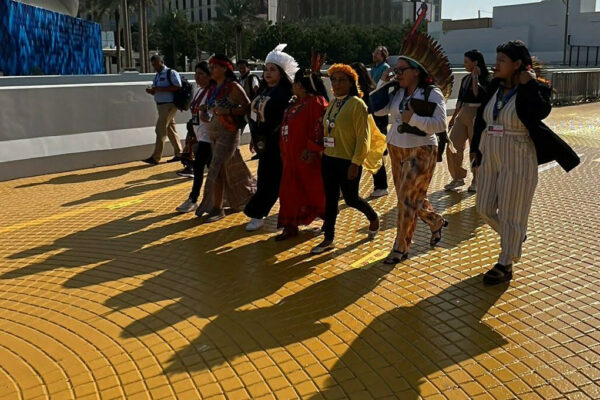Washington – The U.S. Export-Import Bank voted Thursday to reject financing for the controversial 1.6-billion-dollar Camisea gas pipeline project in Peru in what activists hope is a precursor to next week’s scheduled, and oft-delayed, vote by another development bank here.
In a split 2-1 vote, the Ex-Im’s board of directors denied a loan that would have provided 213 million dollars for the venture led by Hunt Oil and PlusPetrol, which has been roundly criticised for its environmental and social impacts.
The bank, the official export credit agency of the United States, assists in financing the export of U.S. goods and services to international markets.
Groups that have lobbied against the project for months welcomed the decision.
“Two Ex-Im board members displayed courage and environmental leadership in the face of considerable pressure,” said Jon Sohn, international campaigner for Friends of the Earth.
“Friends of the Earth applauds Ex-Im’s decision to deny U.S. taxpayer support of Camisea and the massive environmental destruction it would cause,” he told IPS.
“We hope this sends a signal to export credit agencies in Europe that the U.S. Export-Import Bank is committed to international environmental standards,” said Aaron Goldzimer, of Environmental Defence, in a statement.
Bank Chairman Philipp Merrill said in a statement “this decision is situation specific and does not reflect the bank’s overall interest in financing U.S. exports for energy projects throughout the world”.
But the vote might signal a rough road ahead for financing of the project, designed to exploit a huge gas field in the Amazonian region of the country by running two pipelines, some 1,150 kms and 520 kms respectively, through Andean rainforests to Lima and the Pacific Ocean.
It also includes construction of liquefied-natural-gas (LNG)processing plants, one of them immediately adjacent to the Paracas National Reserve, Peru’s only protected marine area, and one of the most important ecosystems – home to extremely rare animal species,including green sea turtles and Humboldt penguins – in the western hemisphere.
On Wednesday, the Inter-American Development Bank (IDB) for the third time this month delayed its vote on whether to finance Camisea.
Activists say the U.S. Treasury Department, which controls about 30 percent of the IDB board vote, asked for the delay.
Earlier this year, Treasury reported that if it became involved in the project, the IDB risked sending a signal that project sponsors can bring poorly designed projects to (international financial institutions) too late in the process to allow for changes.
The project is already about 60 percent complete.
The IDB board is contemplating a 75-million-dollar direct loan and 60 million dollars in syndicated loans for the project. Its vote is expected within one week.
A number of U.S. senators, Peruvian civil society groups, as well as the U.S. agency for International Development (USAID), have already opposed the project on the grounds that a review of its social and environmental impacts was incomplete.
”We hope the board members of the Inter-American Development Bank require that these outstanding environmental and social issues be adequately resolved before making their decision on project financing,” said Amy Gray, Latin America programme manager for the Bank Information Centre (BIC) in a statement.
”Unless the project sponsors make fundamental changes to reduce the project’s environmental and social risks, they can expect to meet obstacles in getting financing,” predicted Amazon Watch Executive Director Atossa Soltani.
”Two changes the sponsors must make are: to abandon plans to drill inside the N-K (Nahua-Kugapkakori) indigenous reserve in the Amazon and to find another location far from the Paracas Marine Reserve for the fractionation plant, added Soltani in an interview.
Besides its environmental impact, the project has provoked growing concerns about its effects on the indigenous peoples who inhabit the Nahua-Kugapkakori Reserve, several hundred of whom have avoided or rejected contact with outsiders and lack immunity to common diseases.
Nearly 75 percent of the project’s gas-extraction operations are located in that reserve.
When Shell undertook exploratory operations in the region in the 1980s, almost one-half of the Nahua people died from introduced diseases, and already evidence exists that contractors working for the Camisea project have actively sought uncontacted groups during the past year.
IDB’s vote will also be influenced by the position of the U.S. government, which appears to have moved away from supporting the project to leaning toward abstaining when a final vote is taken.
However, Hunt Oil, one of the leaders of the project, has
extraordinarily close ties to the Bush administration. Its chief executive, Ray L. Hunt, was a major contributor and fund-raiser for Bush’s presidential campaign.
Activists say they will continue to campaign against the project in advance of the IDB vote.
A list of entertainment celebrities will launch a campaign next week to stop U.S. taxpayer financing for the Camisea project.
”Our work is not done. Given the extent of Camisea’s impacts in the Amazon and on the coast of Peru, our organisations will continue to support efforts to work with the Peruvian government and the companies to reduce the project’s troubling impacts,” said Peter Kostishak,
co-director of the Amazon Alliance. (END/2003)













